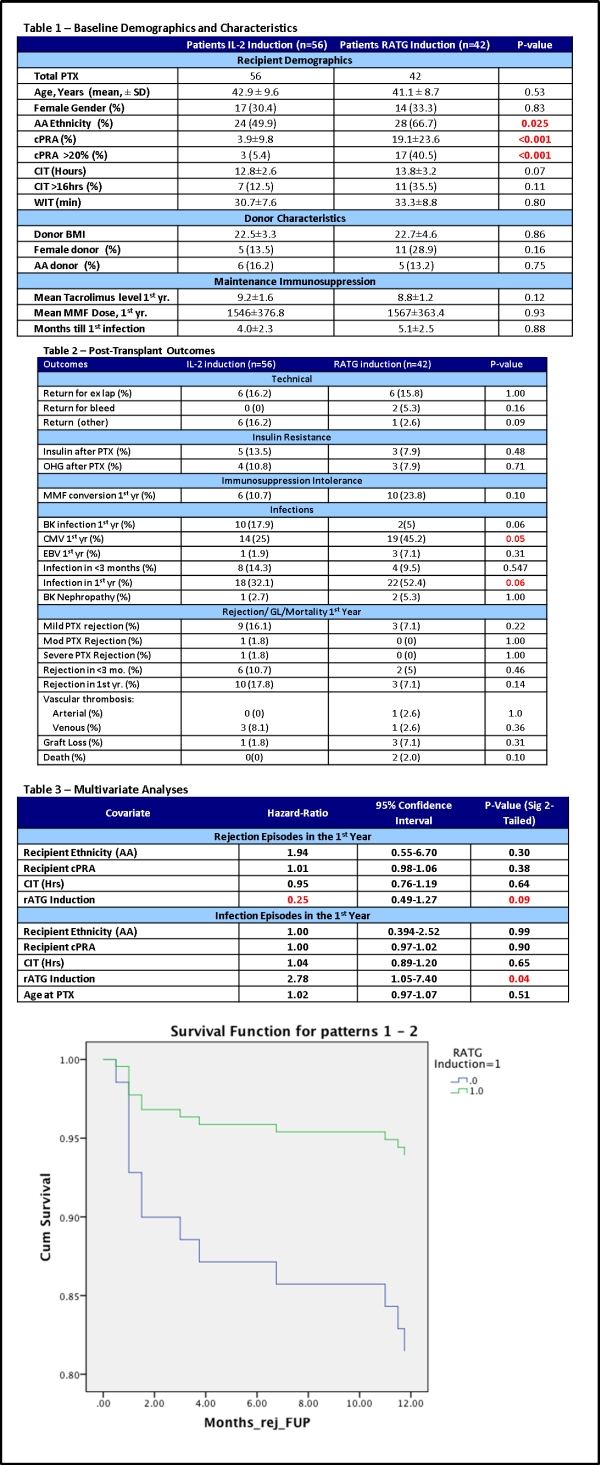Do Induction Therapy, Patient-Level and Post-Operative Factors Impact Outcomes in Moderate to High Immunologic Risk Simultaneous Kidney-Pancreas Transplantation in the Era of Stringent HLA Cross-Matching?
MUSC, Charleston, SC.
Meeting: 2015 American Transplant Congress
Abstract number: C201
Keywords: HLA matching, Immunosuppression, Outcome, Pancreas transplantation
Session Information
Session Name: Poster Session C: More Controversies in Pancreas Transplantation
Session Type: Poster Session
Date: Monday, May 4, 2015
Session Time: 5:30pm-6:30pm
 Presentation Time: 5:30pm-6:30pm
Presentation Time: 5:30pm-6:30pm
Location: Exhibit Hall E
Background: Simultaneous kidney and pancreas transplantation (SPK) is a lifesaving procedure for patients with diabetes mellitus. The success of SPK is dependent upon minimization of immunologic and infectious sequelae. Little data exists quantifying the optimal induction immunosuppression (IS) for SPK. The aim of this study was to determine the impact of patient, operative and IS factors on SPK outcomes. Methods: Using an 8-yr (June, 2006-Dec, 2013) cohort, we conducted a retrospective analysis examining demographic, IS, transplant factors, complications and outcomes after SPK in recipients with IL-2 (Group A) vs. rATG (Group B) induction under our stringent HLA cross-matching protocol. Maintenance therapy consisted of a tacrolimus-based triple immunosuppressant regimen that was constant throughout the time period. Results: Of 109 total SPK transplanted during this time, 98 patients were included in this study (n=56; IL-2 induction and n= 42; rATG induction). There were no significant differences between groups with respect to age, gender, CIT, WIT, donor or maintenance IS (table 1). The rATG cohort was significantly more likely to be AA (p=0.025), have higher mean cPRA (p<0.001) and cPRA>20 (p<0.001). For outcomes, there were no differences in post-SPK insulin resistance, technical complications, IS intolerance or rejection, graft loss or mortality. However, rATG had more CMV infections and overall infections in the first year (p=0.05, p=0.06 respectively, Table 2). In multivariate analysis, rATG showed a trend towards decreased rejection (HR=0.25, p=0.09) and was significantly associated with increased infection (HR=2.78, p=0.04). Conclusions: After controlling for immunologic risk, there was a strong trend towards lower rejection in the rATG group. However, there were more infections in this group as well. Thrombosis, leaks, other surgical complications, graft loss were similar. A more granular methodology to discern recipients in true need of lytic induction in SPK may be required to optimize risk-benefit ratio.
To cite this abstract in AMA style:
Rohan V, Taber D, Taraskiewicz D, Nadig S, Mcgillicuddy J, Chavin K, Baliga P, Bratton C. Do Induction Therapy, Patient-Level and Post-Operative Factors Impact Outcomes in Moderate to High Immunologic Risk Simultaneous Kidney-Pancreas Transplantation in the Era of Stringent HLA Cross-Matching? [abstract]. Am J Transplant. 2015; 15 (suppl 3). https://atcmeetingabstracts.com/abstract/do-induction-therapy-patient-level-and-post-operative-factors-impact-outcomes-in-moderate-to-high-immunologic-risk-simultaneous-kidney-pancreas-transplantation-in-the-era-of-stringent-hla-cross-match/. Accessed December 18, 2025.« Back to 2015 American Transplant Congress
